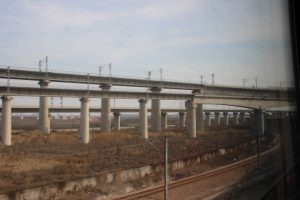This morning we commenced the last leg of our Europe-Asia rail adventure. We were booked in coach 8, beds 9 and 10, on train Z97 to Hong Kong. The journey is scheduled to take 25 hours. Upon arrival at the big and new Beijing West railway station we checked in as normal but because of our destination we were escorted by a policeman to the ground floor where there was a dedicated Hong Kong check-in, immigration service and quarantine. Security was tight again and we took our seat in a small, gloomy waiting area with no more than two dozen other people for the 11:10 a.m. opening time. (The train was due to depart at 12:40. Security takes time in China.) It was the usual routine of photocopying and scanning of passport as well as the removal of our Chinese departure cards and an exit stamp in the passport. This is because Hong Kong, although handed over to the Chinese at midnight on 30th June 1997 by the British, is a semi-autonomous region. This means that on the train we will have to complete a Hong Kong arrival and departure card. As this part of the security was taking place the empty stock for our train was brought into the station to a fenced off and dedicated platform. Essentially we were travelling in a sealed train with only the two dozen people able to make contact with each other. We had our own restaurant and before departure we were in there for lunch.
We left Beijing under clear blue skies which lasted until sunset some 6 hours later.
For the first few hours we ran parallel to the 107 National Road which reminded us of the journeys we have made along the Grand Trunk Road across India and Pakistan. Alongside the road were an almost endless line of engineering workshops, steel fabricators, brickworks, small shops and petrol stations all cheek by jowl with endless traffic and dust. The latter was doused in places with liberal amounts of water that from the train made the road look like a black and slick line across the semi-desert region.
Alongside all of this were more of the green fields which we had seen before but the further south we went the greener and bigger were these first shoots.
We crossed the Yellow River which flows into the Pacific Ocean to the southeast of the Beijing region.
As we mentioned earlier the Yellow River gets its name from the alluvium that it carries from the Chinese Loess Plateau in the northwest of the country which is famed for its mineral rich but easily eroded soil. A report in the China Daily newspaper states that Chinese scientists have discovered that the smog can indirectly reduce water contamination. They discovered that a high level of particulates that make smog has weakened the summer monsoon over the plateau. This has led to less rainfall and therefore less soil erosion, which in turn has reduced the amount of nutrients that cause algal blooms which absorb oxygen from the water, block out the sun and contaminate the water. We have seen that this appears to be true in the upper course of rivers such as the Yellow, but in the lower course, as the photographs here show, algal blooms are present. The article does conclude by explaining that the relationships between human and natural systems are complex and fragile and therefore the headline of the story may not be the whole story.
The sun set over the city of Zhengzhou and darkness fell quickly. Tomorrow we should see a different Chinese landscape.





















